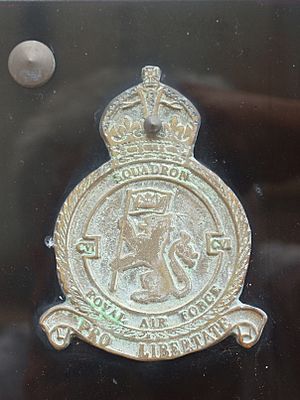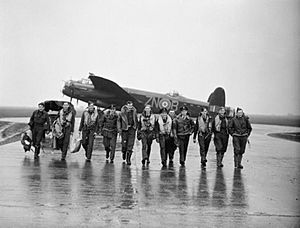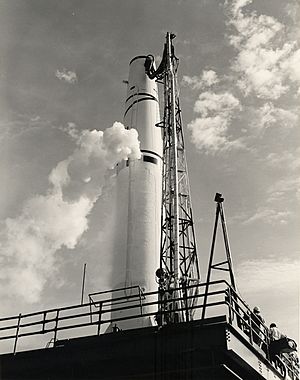No. 106 Squadron RAF facts for kids
Quick facts for kids No. 106 Squadron RAF |
|
|---|---|

The badge of No. 106 Squadron
|
|
| Active | 30 September 1917 – 8 February 1919 1 June 1938 – 18 February 1946 22 July 1959 – 24 May 1963 |
| Country | |
| Branch | |
| Motto(s) | Latin: Pro Libertate ("For Freedom") |
| Commanders | |
| Notable commanders |
Guy Gibson |
| Insignia | |
| Squadron Badge | A lion sejant, rampant, holding a banner charged with an astral crown. Based on the crest of the County Borough of Doncaster, the squadron being stationed near there at the time of adopting the badge. |
| Squadron Codes | XS (May 1939 – September 1939) ZN (September 1939 – February 1946) |
No. 106 Squadron RAF was a special flying unit of the Royal Air Force (RAF). It was active during three different periods: from 1917 to 1919, throughout World War II, and during the Cold War from 1959 to 1963. This squadron played an important role in air operations during these times.
Contents
Squadron History
Early Days and First World War
No. 106 Squadron was first created on September 30, 1917, at Andover, Hampshire. It was part of the Royal Flying Corps, which later became the RAF. The squadron was meant to fly reconnaissance missions, which means scouting and gathering information.
In May 1918, instead of going to the battlefields in France, the squadron was sent to Ireland. There, it helped with army support and policing duties for about 18 months. The squadron was then officially closed down in October 1919.
Reforming for World War II
The squadron was brought back to life on June 1, 1938. It was called No. 106 (Bomber) Squadron. At first, they flew Hawker Hind planes, then Fairey Battles. By May 1939, they started using Handley Page Hampden bombers. These were important planes for the start of World War II.
When World War II began, the squadron was flying Hampdens and training. From March 1941, they started flying regular night bombing missions. Their first bombing raid was on Cologne, a city in Germany. Before that, they also helped by dropping naval mines into enemy waters.
Flying the Lancaster Bomber

In early 1942, the squadron briefly used Avro Manchester planes. But by May, they began to switch to the famous Avro Lancaster bomber. Some of their Manchesters even took part in the huge "thousand-bomber raids" on German cities like Cologne and Bremen in the summer of 1942.
In October 1942, ten of their Lancasters took part in a special low-level raid. They attacked the Schneider Works, a factory in France. Two more Lancasters, including one flown by their leader Guy Gibson, attacked a nearby target.
Important Missions and Bravery
In June 1943, the squadron was part of the first "shuttle bombing" raids. This meant bombing a target, then flying to another base to refuel and re-arm, and then bombing another target on the way back. They attacked targets in Germany and Italy. They also took part in a famous attack on the V-2 rocket research center in Germany. This center was where the Germans developed their V-2 rockets.
In 1944, they attacked coastal gun batteries and hidden storage sites for V-1 flying bombs. These were early cruise missiles used by Germany.
In December 1944, they flew a very long 1,900-mile trip to bomb the German fleet in Poland. In March 1945, they helped bomb the defenses of Wesel in Germany. This helped British Commandos capture the town with very few losses.
The squadron's last missions of the war were in April 1945. They bombed an oil refinery in Norway and dropped mines in the Oslofjord.
During World War II, No. 106 Squadron flew 5,834 missions. They lost 187 aircraft, but their gunners claimed to have shot down 20 enemy planes. The squadron members earned 267 awards for their bravery. One of the highest awards, the Victoria Cross, was given to Sergeant Norman Cyril Jackson. He earned it for his incredible bravery during an attack in Germany in April 1944.
After the war ended in Europe, the squadron helped fly POWs (Prisoners of War) and troops back home. The squadron was finally closed down in February 1946.
Cold War Service
The squadron was reformed again on July 22, 1959. This time, it was a Strategic Missile (SM) Squadron. They were part of a program called Project Emily. The squadron was equipped with three PGM-17 Thor missiles. These were large rockets that could carry nuclear warheads. They were based at RAF Bardney.
In October 1962, during the Cuban Missile Crisis, the squadron was on high alert. Their missiles were ready to be launched at targets in the Soviet Union. Luckily, the crisis ended peacefully. The squadron was officially closed down for the last time in May 1963, when the Thor missile program ended in Britain.
Aircraft and Missiles Operated
| From | To | Aircraft or Missile | Version |
|---|---|---|---|
| May 1918 | January 1919 | Royal Aircraft Factory R.E.8 | |
| January 1919 | October 1919 | Bristol F2B Fighter | |
| June 1938 | July 1938 | Hawker Hind | |
| July 1938 | June 1939 | Fairey Battle | |
| May 1939 | September 1939 | Avro Anson | Mk.I |
| May 1939 | March 1942 | Handley Page Hampden | |
| March 1942 | June 1942 | Avro Manchester | |
| May 1942 | February 1946 | Avro Lancaster I & III | Mk.I & III |
| July 1959 | May 1963 | Thor IRBM |
World War II Bases
| From | To | Station | Notes |
|---|---|---|---|
| September 1938 | August 1939 | RAF Thornaby | |
| August 1939 | September 1939 | RAF Evanton | |
| September 1939 | October 1939 | RAF Cottesmore | |
| October 1939 | February 1941 | RAF Finningley | |
| February 1941 | September 1942 | RAF Coningsby | |
| October 1942 | November 1943 | RAF Syerston | |
| November 1943 | February 1946 | RAF Metheringham |
See also
- List of Royal Air Force aircraft squadrons
- List of UK Thor missile bases


